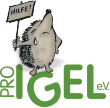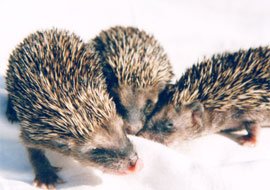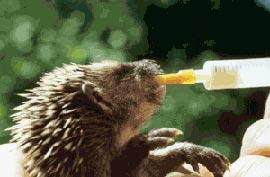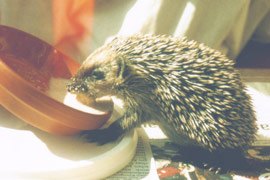It would be impossible for an inexperienced person to rear orphaned suckling hoglets without guidance!
Correct nutrition is crucial when rearing orphaned mammals. You must know the composition of the mother’s milk to be able to choose a suitable milk replacement formula. Cow’s milk (even diluted) and all human baby food (even therapeutic food) is completely unsuitable for baby hedgehogs (hoglets).
In Germany 80% of hedgehogs are born in the months of August and September. In warmer regions like the Rhine Valley and the Saarland, litters can be born as early as June and July.
Orphans found in these weeks are still blind and deaf up to 14 days old. The babies are fed by the mother for the first six weeks of life, and so are helpless without her. These hoglets must be correctly hand reared if they are to survive.
So-called, “Autumn Orphans” are generally fully weaned and independent young hedgehogs. How you should help these youngsters is described in Hedgehog found – what to do?
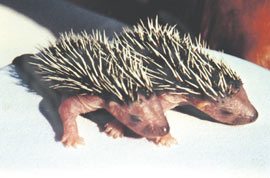
The hoglets must be marked so you can tell which is which, use a tiny spot of non-toxic acrylic paint (or tippex or nail varnish) and mark the spines in a different place on each baby. Each hedgehog should be weighed on a letter balance (or electronic kitchen scales which weigh in increments of 1 g) – at the same time every day – and its weight written on a record sheet.
| Age | Skin colour | Spines | Fur | Eyes Ears | Teeth | Weight (g) |
| At birth | pink | white | none | shut | none | 12 – 25 |
| 1 week | pink | a few dark | none | shut | none | 30 – 50 |
| 2 weeks | grey | dark | bit of fuzz | opening | none | 60 – 80 |
| 3 weeks | grey | dark | visible fur | open | erupting | 100 – 130 |
| 4 weeks | grey | dark | thick fur | open | fully erupted | 140 – 180 |
© Monika Neumeier
Fleas, ticks, fly eggs and maggots must be carefuly removed with tweezers. Never use insecticide or bathe hoglets.
Use a 2 ml disposable syringe (without a needle!) to feed even the smallest hoglet, put a short length of bicycle valve tubing over the tip as a replacement teat. Pipettes and puppy rearing bottles are not suitable! To feed the hoglet, place it on its back in your left hand (if you are right-handed!) and hold it with your thumb. It will “tread” against your thumb with its front feet, as this is how it stimulates the flow of milk from the mother with a rhythmic treading action of its forepaws around her nipples.
Human baby food or milk formula, cow’s milk, semolina, rice or oatmeal gruel etc., honey, glucose or multi-vitamin drops are totally unsuitable for hoglets!
The milk replacer Esbilac ® (German Firma Albrecht, D-88326 Aulendorf), has proved its worth in hand rearing, but it is only available from veterinary surgeons. (Available in UK from “Spike’s World”). Mix a teaspoonful of Esbilac with 2 teaspoonfuls of unsweetened fennel tea and add one small drop of Vitamin B complex (one drop per all hoglets of a litter!) once a day. If you haven’t got any Esbilac for the first day in care and no longer – feed luke-warm, unsweetened fennel tea to hoglets who are only a few days old
The correct amount of food to give in a 24 hour period equals one quarter of the hoglet’s bodyweight. Until the eyes and ears are open, feed the hoglet eight times during the day and twice during the night. Gradually the number of feeds is reduced, and the amount given at each feed increased. Hoglets weighing about 100g only need 5 feeds every 24 hours. The daily weight gain should be 4-7g per day up to a bodyweight of 90g and thereafter up to 10g or more per day.
Toiletting is the opposite of feeding. Young hoglets cannot yet spontaneously defecate or urinate, the mother stimulates them to do this by licking their tummies and genitals. After every feed, the carer must massage with a damp finger or cotton bud until a successful outcome is reached. At this stage, the droppings consist of little pale green clumps.
When the milk teeth erupt – at about 19 days old, in addition to their usual feeds, put some replacement milk in a flat dish like a jam-jar lid. Little by little mix into the milk increasing amounts of mashed scrambled egg, very finely minced, lean beef, or tinned cat food, to get them used to adult food. Dilute the replacement milk more and more and increase the amount of solids. When the young hedgehogs are about 30 days old they should be completely weaned – even though their food is still finely chopped or mashed – and only give them water to drink.
Further care: Once the hoglets are eating for themselves, it may already be necessary to divide them into smaller groups of similar bodyweight. You will need to prepare more and more food bowls! When they are about 5 weeks old and weigh 250-300g, they should be separated from their siblings and housed individually.
When they weigh between 220-250g (later in the year, wait until they weigh more e.g. 350g at the end of September) put the youngsters outside in a spacious enclosure. They must learn to forage for natural food and to catch their prey. After about 2 weeks you can open the enclosure. Read more about this under Release.
If you see baby hedgehogs (hoglets) or a mother hedgehog with her young, or if you find orphaned hedgehogs or they are brought into your rescue centre either with or without their mother: Please support hedgehog research and complete our (German) Online litter questionnaire!

